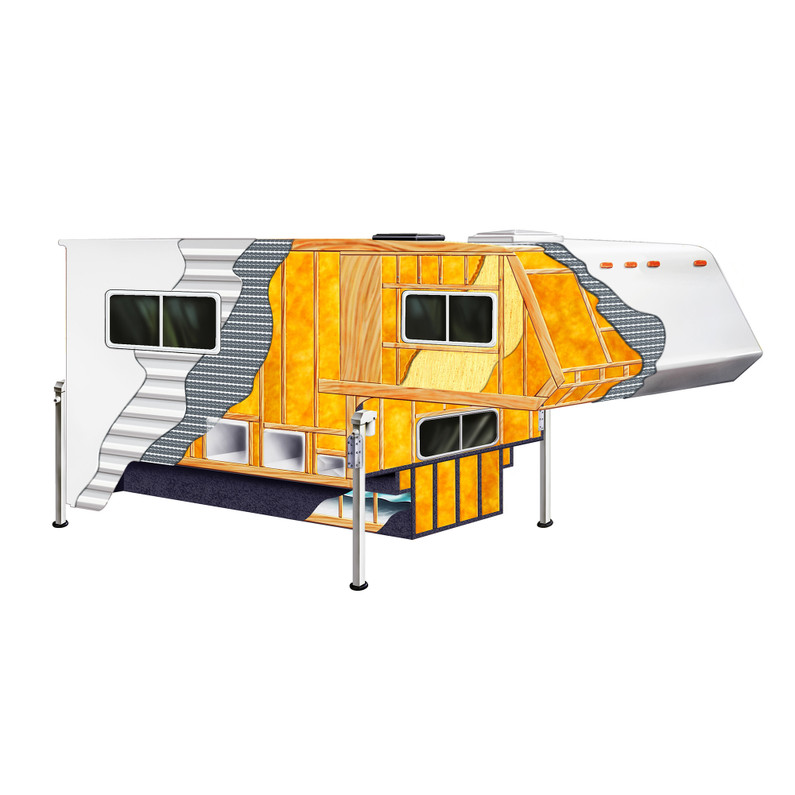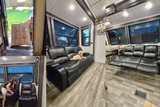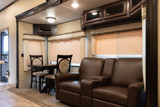How is it Made: RV Edition
Are you the type of person who wonders how things work? Do you ponder the pros and cons of alternating current or direct current? Does understanding how things are made fascinate you? Do you change the oil on your car yourself or at least watch how it’s done at the service station? Have you ever wondered how Recreational Vehicles are built?Having a clue when it comes to the manufacturing process is essential to understand issues like quality, durability and simply because it is an interesting topic that will make great dinner conversation in the future.
Constructing a stick built house is said to go from the ground up. You start with a foundation, add framing, put on the trusses, install walls, cabinets, and apply paints and finishes. Unlike building your own house, building an RV is done outside the scope of your supervision. Unless you have purchased a custom-made RV, you will most likely buy one that has been built to manufacturer specifications and not your own. But, just like a stationary home, an RV is also built from the ground up and the manufacturing process is much home construction.
The first component of your RV will be the construction of the chassis. Some experts in the field would tell you that this is actually the most important consideration. The chassis refers to the frame, similar to the foundation of a home. This is the component that will carry the weight of the RV and a sturdy, high-quality frame will hold up for the long haul and provide a better weight rating.Add to that the other out-of-sight parts that are necessary to make the RV mobile – drive train, engine, suspension system, etc. – and what’s underneath becomes as important as what’s inside.
The chassis is a blank canvas. From this, every manufacturer and every Class style has its own specs on how these are built.One design that has become an industry standard, for the most part, is the semi-monocoque which uses the traditional frame rail design and adds cross braces and other structural elements to provide more stability while on the road and a means to absorb the bumps along the way. Many times the frame is manufactured by a secondary manufacturer and provided to the RV company; other times the RV manufacturer makes its own frames or oversees necessary modifications.
The best choice to ensure that the frame will weather well is if it is constructed using a galvanized metal. Simply applying a coat of black paint to a metal frame will offer protection, but not as compared to a galvanized steel frame. Other frame coating options include powder coating or any of the techniques used by automakers to protect cars and trucks.
Once the frame is in place, the next step is to construct the outer walls. Three types of materials are used most often in building a motorhome. Aluminum, steel or wood are all acceptable in the construction process. While wood is often considered inferior when it comes to durability, longevity and the economics of manufacturing, wood has been used as the bones of motorhomes for decades. It is also easier to repair if needed. As long as it is kept dry and out of the elements, it is strong and reliable.Aluminum is lightweight but still provides the strength needed to support the exterior walls of the RV. Along with steel, these two man-made materials are more expensive to use. And modifications needed later on are more difficult with metal frames as it is difficult to modify the structure.
Now it’s time for the skin. The exterior panels of today’s motorhome can be either laminate or fiberglass, the latter most often used with metal frame construction. With laminated construction, the walls are attached in one step, with the exterior, insulation and interior walls are literally glued together using a construction adhesive. Through pressure and enough drying time, the walls are bonded and strong, but still light.
As far as what the exterior walls are made with, aluminum and fiberglass are the options and each has advantages and disadvantages. Corrugated aluminum is easy to repair while its smooth counterpart would likely require the expertise of an auto-body shop. Improvements made to fiberglass construction through the years makes it more sturdy and efficient than previously, and today’s version is made to withstand sun, wind and other damaging elements.
In between the outer skin and the interior walls is insulation. Its purpose in a motorhome is exactly the same as its purpose in a regular house – to keep heat and cold out so the climate control equipment can do its job effectively and efficiently. Spun fiberglass and spray foam are the most common types of insulation used in the making of motorhomes and trailers.
To top it off, construction moves to the roof. This is the side of the motorhome that is exposed to the most extreme conditions – full sun, rain and snow, hail, falling branches and other debris, as well as wind and storms. Aluminum is a good choice with long-lasting capabilities. It costs less and any damage can be fixed easily. Rubber and plastic based roofing materials are also used. Advantages to these are the cost for manufacturers and durability.
One of the final steps before all the finishes go in is the installation of the windows. It is critical that these are installed correctly, making sure they are water and airtight. A dual pane window is the best option, and just like their use in homes, provide an insulation factor as well as serve as soundproofing.
After the shell is built and ready to go, the prettying begins. Cabinets, sleeping accommodations, appliances, countertops and amenities are the icing on the cake. The surface choices are up to the manufacturer and buyer, but as long as the outer shell is weatherproof and well-constructed, everything inside will be well protected.
The manufacturing process is a lot more complicated than explained here. There is a logical progression from a basic frame to the final product, destined to create memories across the miles for the lucky RV buyer. Manufacturers have media resources available on their websites that detail their own construction processes. In 30 minutes – more or less – you can get a quick tutorial on how the RV of your choice is put together.Having this knowledge could come in handy when selecting your RV as well as taking care of it in the future. As with anything, knowledge is key.
Lois Tomaszewski is an award-winning journalist and former newspaper editor.
Recent Posts
-
Traveling to the RV Hall of Fame in Elkhart, IN
If you are traveling to Elkhart, IN to see the RV Hall of Fame, getting off the toll road at exit 96 …Nov 14, 2025 -
Best RV Air Conditioners of 2025: An Expert Guide From RecPro
Quick Answers Best overall RV air conditioner: RecPro 15K Quiet AC with Heat Pump (RP-AC3800) Best f …Oct 29, 2025 -
The Nuclear Nomads Expand Sofa with New Recliner Section Install
The Nuclear Nomads are a full time RV family living in south Florida. Andi and Joey value quality ti …Oct 24, 2025 -
Trailer Wiring Guide: How to Wire Your Trailer for Safety and Efficiency
Table of Contents 1. Common Types of Trailer Connectors 2. Trailer Wiring Diagrams: Color Codes and …Aug 20, 2024 -
How to Keep Your Pets Safe While Camping
RVing and camping are a great getaway from the hustle and bustle of work and the city and the day-to …Jul 02, 2024 -
Why Replace Your RV Furniture?
You may wonder when is the best time to replace your RV furniture. There is no one right answer to t …May 20, 2024







